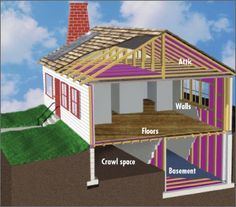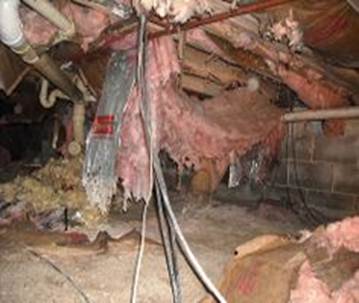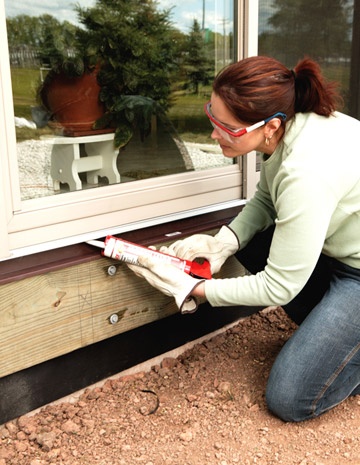Crawlspace Insulation Review

Learn about Different Types of Crawlspace Insulation, Installation and Removal Process
Crawlspaces are very common occurrences, regardless of the age of your home, since these are usually built under the house foundation, making some free space between the ground and the bottom floor, thus keeping your interior safe from underground processes, including cold, moisture and damp which can seriously damage the interior in time. These are usually built instead of basement spaces which are a more costly option, why people usually tend to opt for crawlspaces instead of basements, and use them for placing heating or plumbing. Now, these spaces can server their purpose but in time, they can present more of a problem than a solution, since a lot of moisture can build up within and if not properly insulated, these crawlspaces can serve as a path for the moisture to travel all the way up to your bottom floor. This problem can be solved with proper insulation, why we herewith offer a crawlspace insulation review.
Removing Crawlspace Insulation
Bearing in mind that the crawlspace needs to be somehow protected, it does not come as a surprise that the crawlspace under your home already has some insulation installed. If this is the case, before moving onto choosing insulation and installing it, you will need to check the state the exiting insulation is in, if any. If you have determined that the crawlspace insulation installed is in a bad shape and needs to be removed, please follow the herewith given steps:

- Since the most commonly used material is fibreglass, you should know that it can be somewhat irritant for the skin and should not be inhaled, why you should always wear protective equipment when removing crawlspace glass wool insulation, including a face mask, long sleeves and gloves.
- Determine your starting point (best work from one corner to another) and once you have removed the material holding the added insulation in place, try to remove the entire insulation material installed, rather than tearing it piece by piece, since this is much tidier and will not leave a mess for you to clean up.
- Always prepare the container for the removed insulation. If you manage to remove it entirely in one piece, then you can simply rolled it back and dispose it that way. On the other hand, you will need to place the pieces in a plastic bag and dispose of it properly. Make sure to consult local regulation on disposing of removed insulation.
- Finally, prior to adding a new crawlspace insulation layer, make sure to remove all the insulation by using an air hose and properly disinfect the pipes or ducts placed in the crawlspace so that any moisture, germs or odours remaining are removed.
Crawlspace Insulation Installation Tips
Once you have removed old, worn out insulation, it is time to properly install fill up the crawlspace with new insulation. Here, the most commonly used insulation options are glass wool rolls or foam panels that are used on the exterior and can easily be installed by using some staples or proper bondage adhesive. Some alternatives in crawlspace insulation materials include liquid foam insulation that is usually used to fill gaps and hole from the inside but is not the best solution for humid climates or cellular glass insulation.
If you are not battling with serious moisture problems, you have probably opted for some unfaced glass wool insulation which is very easy to install and will keep your feet warm during the winter. The installation process is pretty straightforward, so all you need is enough insulation material and some accessory tools for the job. Again, as upper mentioned, make sure to wear proper safety equipment during installation. Note that the insulation material should extend from the mudsill down the wall and approximately 0,5 metres out onto the floor. Use 2x2 cleats to secure the insulation and drive nails through them into the mudsill edge. You can add a few bricks over the insulation material at the bottom of the wall, to hold the crawlspace insulation in place. In order of avoiding potential gaps in the insulation, use leftovers of the material to fill the gaps between the joists.

A Few Additional Word of Advice...
Now, apart from some basic information on removing and installing crawlspace insulation, there are a few more things you should be aware of.
Firstly, although people tend to completely block the crawlspaces under their homes, this may not always be the best idea. Namely, not only is proper ventilation somewhat obligatory, it can also be very useful, depending on the season. Basically, during summertime, the vents will allow the air to circulate and thus prevent moisture and damp from raising up. On the other hand, the vents should be closed during winter, since cold air may cause pipe freezing. This is why it is better that you include vents in your crawlspace design, but only block it during winter by using specially designed foam blocks.
Finally, if you are dealing with extremely cold insulated crawlspace and you are considering running a duct through in order of providing additional heat source, please bear in mind that the duct should also be properly insulated, since great temperature differences between the air and the duct can cause condensation which will in time lead to rust, corrosion and mould. Another important thing is that you should make sure that the duct is long enough so it goes under an entire room and emits enough heat for the space above to be well heated.
Need insulation products with a fast delivery time and low price? Send your enquiries to info@insulationshop.co.


















































































































